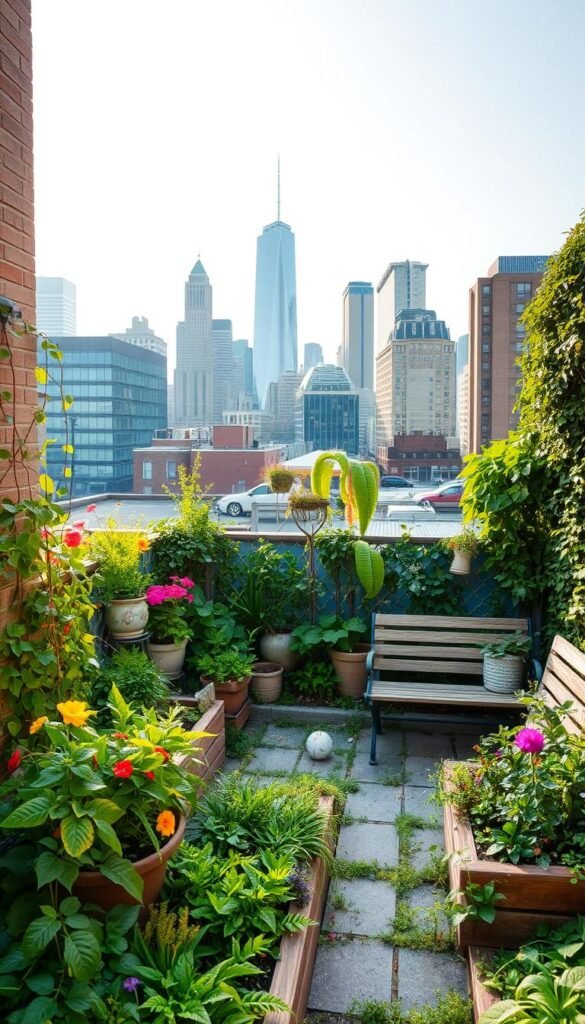Imagine stepping outside your door to a lush, thriving green space that nourishes both your body and the planet. What was once a concrete slab can become a vibrant ecosystem teeming with life. This isn’t just about gardening—it’s about reimagining how we connect with nature in our daily lives.
City dwellers across the U.S. are discovering how small outdoor areas can make big environmental impacts. Studies show urban green spaces reduce local CO2 levels by up to 20% while cooling neighborhoods during heat waves. Your patio could become part of this movement, offering fresh herbs, pollinator habitats, and cleaner air.
Creating an eco-conscious garden starts with simple choices. From drought-resistant plants to natural composting methods, every decision supports healthier ecosystems. Even compact setups can mirror the benefits of larger green areas shown in community garden projects that revitalize urban food systems.
This guide will show you how to work with natural cycles rather than against them. You’ll learn to prioritize soil vitality, embrace biodiversity, and create a sanctuary that gives back to the environment. Let’s unlock your outdoor area’s hidden potential—one sustainable step at a time.
Getting Started with Your Urban Eco Garden Journey
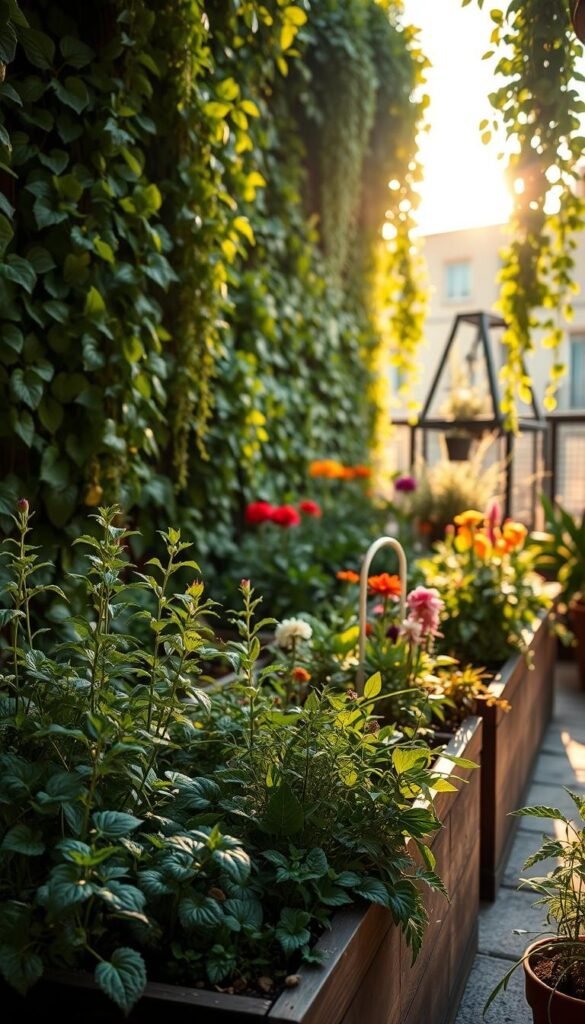
Your outdoor area holds untapped potential to become a living sanctuary. Whether you have a balcony or paved patio, thoughtful planning turns limited square footage into a dynamic ecosystem. Let’s explore how to align your vision with nature’s rhythms.
Why Green Spaces Matter in Cities
Nurturing plants does more than beautify your space—it boosts mental clarity and physical health. Studies reveal that 30 minutes of gardening can lower stress hormones by 25%. Your leafy companions also filter airborne toxins, creating cleaner air within 10 feet of their foliage.
Growing herbs or veggies slashes grocery trips while reducing packaging waste. “A single tomato plant yields up to 15 pounds of food annually,” notes urban agriculture researcher Dr. Elena Torres. This hyper-local approach keeps your meals fresh and cuts carbon emissions from transport.
Designing With Purpose
Start by asking: What do you want your garden to achieve? Food production? Butterfly habitats? Maybe a calming retreat? Sketch sun patterns—most edibles need 6+ hours of direct light. Measure your area’s dimensions, noting permanent features like railings or walls that could support vertical gardening.
Consider joining community gardening initiatives to share resources and knowledge. Even small patios contribute to urban wildlife corridors when planted with native species. Your green corner could spark a neighborhood movement toward sustainable practices.
Assessing Your Patio and Soil Health
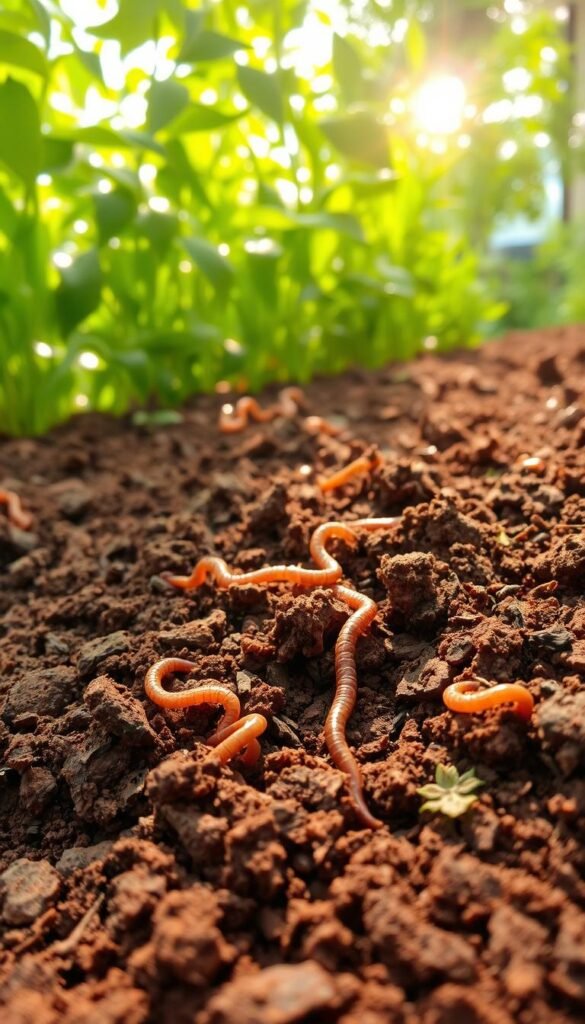
Before planting your first seed, understanding your patio’s unique conditions sets the foundation for success. This phase turns guesswork into strategy, helping you work with your space rather than against it.
Creating a Site Map and Taking Measurements
Grab graph paper and sketch your patio’s layout. Note permanent fixtures like walls or electrical outlets. Track sunlight every 2 hours—mark zones that get full sun (6+ hours), partial shade (3-5), or full shade.
Wind patterns matter too. Observe which areas get breezy mornings or still afternoons. Use this data to place taller plants as windbreaks or position delicate herbs in sheltered corners.
| Sun Exposure | Best For | Sample Plants |
|---|---|---|
| Full Sun | Vegetables & Herbs | Tomatoes, Basil |
| Partial Shade | Leafy Greens | Spinach, Mint |
| Full Shade | Ferns & Moss | Maidenhair Fern |
Testing Soil Quality and Nutrient Needs
Urban soil often hides surprises. Test kits ($15-$30) check pH and key nutrients like nitrogen. For heavy metal concerns, send samples to local extension offices.
If results show contamination, raised beds filled with organic compost offer a fresh start. This aligns with permaculture design principles, creating closed-loop systems that nurture long-term soil health.
Even poor soil improves over time. Mix in coffee grounds for acidity or eggshells for calcium. Your garden space becomes a living lab, adapting as you learn its rhythms.
Transforming a Patio into an Eco Garden: Organic Practices for Urban Spaces
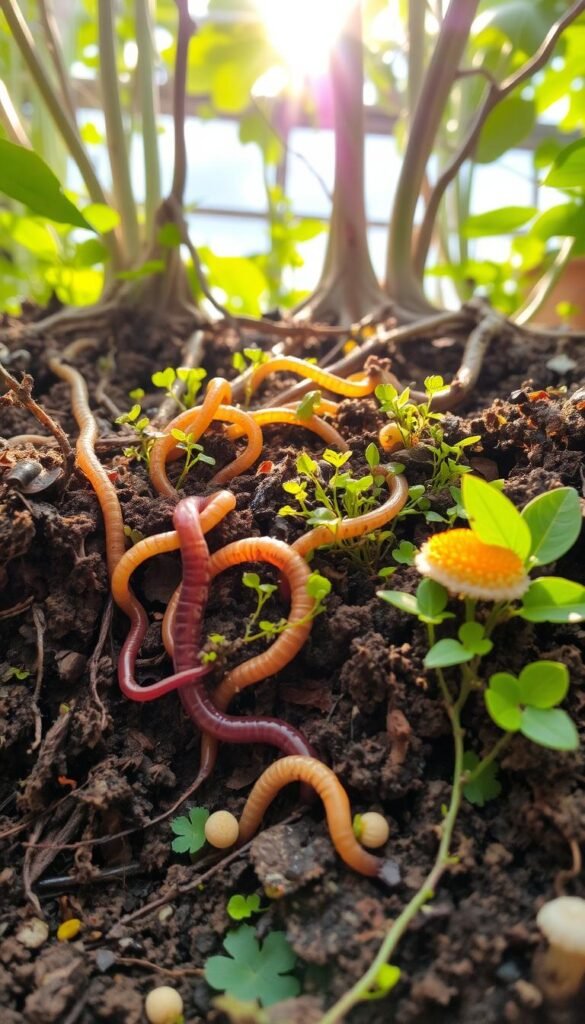
Healthy soil acts as your garden’s living engine. Unlike traditional approaches, regenerative gardening focuses on nurturing this underground ecosystem first. Think of earthworms as your tiny tillers and fungi as nature’s internet connecting plants.
Diverse plant groupings outperform single-crop layouts. A mix of flowers, herbs, and vegetables creates natural pest control. Marigolds repel nematodes while basil improves tomato flavor. This polyculture approach mimics wild ecosystems.
| Method | Benefits | Space Use |
|---|---|---|
| Monoculture | Simpler harvest | High risk |
| Polyculture | Natural pest control | Efficient |
| Vertical layering | Maximizes yield | Space-smart |
Regenerative practices turn waste into resources. Kitchen scraps become compost tea. Fallen leaves transform into mulch blankets. Each action builds soil carbon – nature’s storage system for excess CO2.
Your urban garden becomes a sanctuary for life when you prioritize relationships over individual plants. Ladybugs patrol for aphids. Earthworms aerate compacted earth. This living network thrives when you work with nature’s wisdom.
Sustainable Design with Nature-Based Solutions
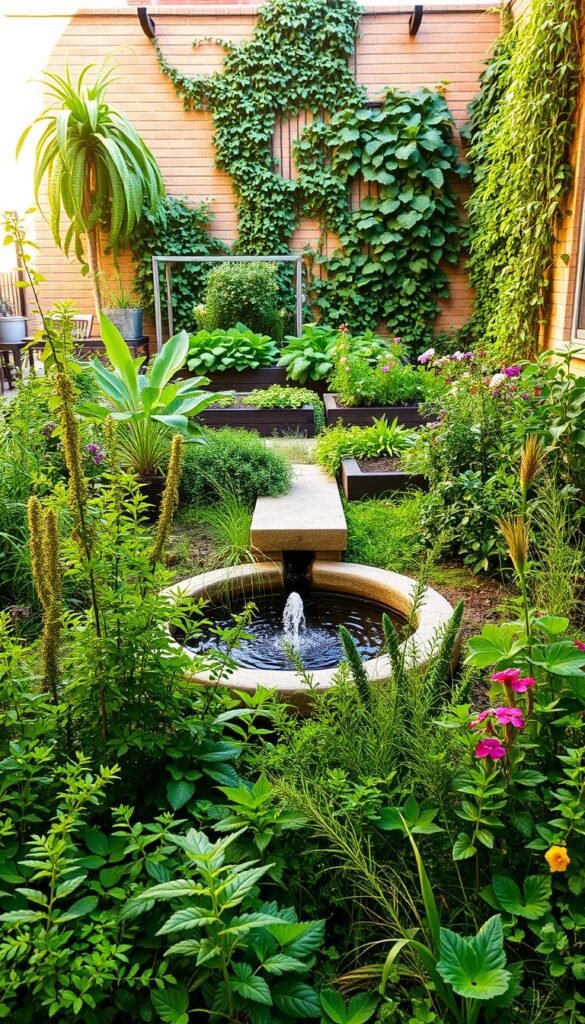
Nature thrives on partnerships, not isolated elements. Your outdoor space becomes a living tapestry when you mirror wild ecosystems through strategic pairings and smart material choices. This approach reduces maintenance while boosting biodiversity and resilience.
Interplanting and Beneficial Blooms for Biodiversity
Mix aromatic herbs like basil with tomatoes to repel pests naturally. Marigolds add fiery beauty while deterring root-knot nematodes. These combinations create microhabitats where ladybugs and lacewings patrol for aphids.
Flowering plants serve dual roles. Sunflowers tower as pollinator magnets, while creeping thyme blooms attract predatory wasps. “Diversity above ground feeds life below ground,” observes landscape designer Mara Klein. Your garden becomes a mosaic that supports entire food chains.
Prioritizing Native Species and Mulching for Efficiency
Local plants thrive in your climate with minimal fuss. Purple coneflowers withstand summer droughts, while native strawberries resist fungal diseases. These species evolved alongside local wildlife, offering perfect nesting materials and food sources.
Spread 3 inches of wood chips or shredded leaves around your plants. This living blanket:
- Slows water evaporation by 70%
- Suppresses weed growth naturally
- Feeds earthworms as it decomposes
Your garden becomes self-sustaining when you work with nature’s rhythms. Every layer—from soil microbes to fluttering butterflies—contributes to a balanced ecosystem that flourishes year after year.
Building Healthy Soil Through Composting and No-Till Methods
Healthy soil isn’t just dirt—it’s a living network of microbes, fungi, and nutrients working beneath your feet. By avoiding disruptive digging and recycling kitchen leftovers, you create a self-sustaining system that feeds plants naturally.
Working With Nature’s Blueprint
No-till methods protect delicate soil structures. Instead of turning earth, use a broadfork to gently aerate without destroying microbial highways. Raised beds filled with organic matter let roots thrive while avoiding compacted ground. For small spaces, try upcycled containers that improve drainage and mobility.
Turning Scraps Into Superfood
Your kitchen waste becomes plant fuel through composting. Start with a compact bin or worm tower. Layer vegetable peels (green materials) with shredded paper (brown materials) to balance nitrogen and carbon. Turn the pile weekly to speed decomposition.
| Green Materials | Brown Materials | Do Not Compost |
|---|---|---|
| Fruit scraps | Dry leaves | Meat/dairy |
| Coffee grounds | Cardboard | Plastic |
This process cuts landfill contributions while creating nutrient-rich humus. Spread finished compost around plants to boost soil health naturally. Your garden becomes a closed-loop ecosystem where nothing goes to waste.
Efficient Water Management and Wildlife Integration
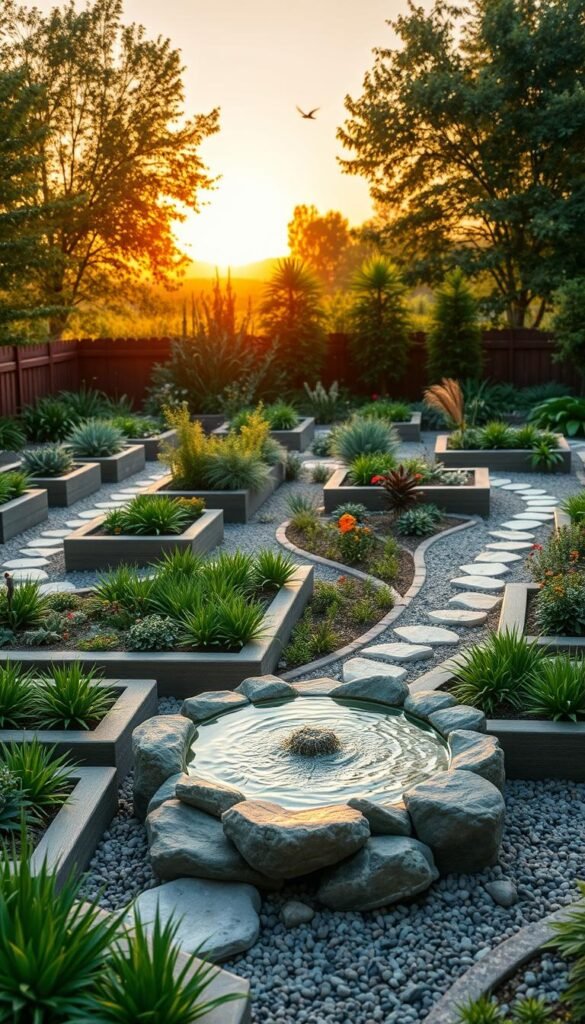
Smart water use transforms how your garden thrives in city settings. Pair conservation methods with wildlife-friendly designs to create a self-regulating ecosystem. Let’s explore systems that save resources while inviting nature’s helpers.
Installing Rainwater Catchment and Drip Irrigation Systems
Capture free water with rain barrels connected to downspouts. A 1,000-square-foot roof collects 600 gallons during 1″ of rainfall—enough to water plants for weeks. Use mesh screens to block debris and overflow pipes to prevent flooding.
Drip lines deliver hydration straight to roots, cutting waste by 60% compared to sprinklers. Pair timers with moisture sensors for precision watering. For small spaces, try self-watering containers that reduce daily maintenance.
| Method | Water Savings | Best For |
|---|---|---|
| Drip Irrigation | 50-70% | Vegetables & Shrubs |
| Soaker Hoses | 30-50% | Flower Beds |
| Hand Watering | 0-20% | Potted Plants |
Attracting Beneficial Insects and Creating Habitats
Invite natural pest control by planting yarrow, dill, and sunflowers. These blooms feed ladybugs and lacewings—predators that devour aphids. Leave some leaf litter for ground beetles that hunt slugs.
- Install bee hotels using bamboo stalks
- Place shallow dishes with stones for water access
- Grow native milkweed for monarch butterflies
Your garden becomes a wildlife hub when you provide food, water, and shelter. These allies handle pest issues naturally, reducing need for sprays.
Maximizing Yield in Limited Urban Spaces
Even the tiniest balcony can become a powerhouse of fresh produce with the right approach. Strategic planning helps you grow more food while respecting your space constraints. Let’s explore techniques that turn vertical surfaces and clever timing into your greatest allies.
Leveraging Container and Vertical Gardening Techniques
Stackable planters let you grow upward instead of outward. Try hanging baskets for strawberries or wall-mounted pockets for herbs. Fabric pots work well for tomatoes, allowing roots to breathe while saving floor space.
Choose compact varieties labeled “patio” or “dwarf.” Pair climbing beans with trellises, or train cucumbers up balcony rails. This container gardening approach transforms walls into edible landscapes.
Optimizing Crop Rotation and Succession Planting
Swap crops seasonally to keep soil nutrients balanced. After harvesting lettuce, plant fast-growing radishes. Follow summer peppers with fall kale—this way, your container stays productive year-round.
Stagger plantings every 2-3 weeks for continuous yields. Sow new basil seeds as mature plants get harvested. With smart timing, your urban garden becomes a non-stop food factory, even in limited space.

